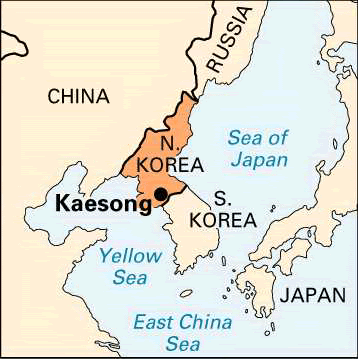I Go On Vacation and Kaesong Starts Tours!!!?

A friend of mine recently uploaded some pictures of her and some friends in Kaesong. Now I know that Kaesong is the North Korean city where they have the big product production complex and I know a few people connected with the government and/or business who have had the chance to tour Kaesong.
However, wow, normal ESL teachers roaming through Kaesong, snapping pics and uploading them to Facebook? Now that's cool.
As I'm still on vacation, I don't know much about the details. However, here is an interesting New York Times article talking about it. Now it's time for me to grab some breakfast.
I just hope they'll continue to run until I get back.
Eager South Koreans Tour a Semi-Open City in the North KAESONG, North Korea — Under the gaze of a bronze statue of Kim Il-sung standing atop a hill, a convoy of 11 buses packed with South Koreans wound its way through this quiet city center in North Korea, which was opened up to daily tours early in December and is now suddenly host to hundreds of mostly South Korean tourists seven days a week.
Bus No. 1 came to a halt at a street corner, temporarily blocking two middle-aged North Korean women from crossing the street and producing a telling moment in the short history of tourism in the North. Finding themselves only feet away from North Koreans — real, live North Koreans who were neither guides nor minders — the South Korean tourists stared at the two women outside, some even pressing their noses against the bus windows.
The two women, wearing gray overcoats and the kind of high-heeled boots that seemed to be in fashion here, smiled in embarrassment. Then they waved at the South Korean tourists, who waved back just as the bus started moving.
And so went a recent visit to Kaesong, the product of a rare period of relative openness in the North, which strictly controls even the glimpses it provides of itself to the outside. Waved to, most women waved back. Men nodded. Schoolchildren, who could be seen going about unaccompanied by adults, did not fail to return a wave.
Although the North missed its year-end deadline to declare all of its nuclear activities and disable its main nuclear site, it seems to be on track to do so eventually. Its improving relations with the United States were punctuated recently by the announcement that the New York Philharmonic would play in Pyongyang, the capital, in February, at North Korea’s invitation.
Entry by foreigners to Pyongyang tends to be strictly controlled. But the tours to Kaesong, like those to the Mount Kumgang area in North Korea’s southeastern section, are open to all foreigners, including journalists, as long as they pay the fee of about $180 for a one-day trip.
The Mount Kumgang area has received outsiders for almost a decade now, but it remains a Potemkin-like resort fenced off from surrounding villages. By contrast, Kaesong is a real city, one that, judging from the hand-painted wooden traffic signs and total absence of cars on its often unpaved streets, the authorities have not tried to transform into a Pyongyang-like showcase.
An ancient capital that eventually fell to the North during the Korean War, Kaesong lies just north of the demilitarized zone dividing the Korean Peninsula and is a two-hour drive from Seoul. It is considered richer than other parts of the North because thousands of its residents work in a South Korean-run special industrial zone just outside the city.
The tours here start in Seoul around 6 a.m. and are run by Hyundai Asan, the South Korean company that developed the industrial zone and is planning to start regular tours to Mount Paektu, along the North’s border with China, and possibly to Pyongyang next spring.
One morning last week, most of the tourists were elderly South Koreans, though they included the young as well as non-Koreans.
Once inside North Korea, South Korean guides reminded the tourists that taking photographs from inside the bus, or of anything but approved tourist spots, was forbidden. The convoy went up the highway alongside the expanding special industrial zone and past hills denuded of trees.
“Let’s get rid of U.S. imperialism!” read a red-and-white banner on the side of a building next to the highway.
The first stop was Pakyon Falls. South Korean tourists posed for photos in front of the 121-foot waterfall, many of them trying to get the falls as well as a North Korean guide holding a big white bullhorn in the same picture. “Take a picture with the waterfall,” the guide told one man who had mustered up the courage to ask her directly to pose for him.
At a stall selling drinks, though, a saleswoman dressed in a Christmassy pink fur-collared costume welcomed photographs and said flirtatiously that she should be paid a modeling fee.
“Ginseng tea? Coffee?” she offered.
One of the many North Korean guides traveling inside the buses came over. Smiling broadly, the guide, who was in his 40s, said he had been dispatched from Pyongyang to help out with Kaesong’s opening.
“It would be good to normalize relations with the United States,” he said, expressing an opinion repeated by two other guides. “We could focus our resources on developing our economy. From the U.S. perspective, it would no longer be threatened by our nuclear arms.”
“Our relations began improving after our nuclear tests last year,” he added, dragging on a cigarette. “The U.S. is basically afraid of nuclear proliferation, and we showed them who we are.”
Another guide, in his 30s, said normalization would allow North Korea to shift its resources from defense so that it could become an “economic power.”
Compared with guides at Mount Kumgang or the Kaesong industrial complex a couple of years ago, some of the guides here, who wore elegant long overcoats and scarves, were indistinguishable from their South Korean counterparts.
“I also sell fresh mountain water,” the woman at the stall said in a sing-song voice. “I even sell hangover pills.”
One bus was filled with South Koreans who had grown up in Kaesong and were returning for the first time in six decades. Everything had changed, they said, except the very same tourist spots they were visiting.
On the steps leading to Sungyang, a Confucian lecture hall, another North Korean guide with a white bullhorn was dramatically interrupted by an old man who jabbed a large finger in the air and yelled out: “Why isn’t there a nameplate on the entrance? Every Korean house should have a nameplate.”
Flustered, the guide remained speechless as the South Koreans streamed past her into the hall. Inside, though, she said, “The Japanese imperialists took the nameplate and burned it during the occupation.”
Later, the man with the large finger, Lee Hee-tae, 80, who had lived here until the Korean War, said he was dissatisfied with the answer. “I don’t think the Japanese took it,” he said, “because I saw it after the end of the Japanese occupation.”
Overhearing his comments, a young North Korean guide asked, “Is there anything wrong?”
After listening to Mr. Lee’s explanation, the guide said simply, “I can’t believe you remember what happened 60 years ago.”












No comments:
Post a Comment
Hey there! Thanks for visiting my blog. It's my first blog, and I'm glad folks are still stopping by even though I'm no longer living in South Korea. Feel free to comment. If you want a personal answer, leave your email, and I won't publish the comment. Nasty comments and spam links will not be tolerated.